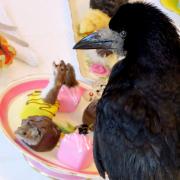
There’s a problem with the group Christmas Exhibition at Broughton Street’s Union Gallery. At least from this reviewer’s point of view.
The show is – as we’ve come to expect – a well-judged selection of varied styles and approaches by contemporary artists. But the work of one in particular is so arrestingly odd, so full of thought-provoking incongruities, that it’s hard to talk about anything else in the same breath.
So, we’ll return to the many excellent pieces by other artists later in the week, and for now grasp the elephant in the room by its amply unspeakable testicles: Samantha Boyes’ High Tea.
Boyes’ ensemble is purchasable separately as 36 individual pieces. It comprises a long table exquisitely set for a traditional afternoon meal. On it appear a linen tablecloth, delicate crockery and silver cutlery, a chocolate gateau, bread rolls, cupcakes, éclairs and neatly cut sandwiches.
And on, out and through these delights emerges a cornucopia of British wildlife: rook, jackdaw, moles, mice, pheasant, pigeon, weasel, puffins, rabbits, voles, giant centipede, spiders, ladybirds, sparrowhawk, toads, songbirds, butterflies, rats and bees – or bits thereof. All of them marvels of the taxidermist’s art.
Some seem surprised. Some unconcerned. Some jump snarling out of the icing.
The effect of this danse macabre is thoroughly disconcerting. Judging by those this reviewer viewed viewing the work, that visceral discombobulation resolves pretty quickly into either delight or disgust. But why?
I think there are at least six ways to approach the pieces, many of which occur involuntarily and at once.
It’s long gone out of fashion, perhaps owing to its associations with the hunting/shooting/fishing set, 19th-century museology’s kill-and-pin approach to taxonomy, and disrespectful Victorian whimsy over squirrels and kittens playing cricket in a box.
But taxidermy as a way of studying or reanimating the dead is an altogether more serious, scientific and interesting phenomenon.
Its contradiction between apparent life and evident death is partly what provokes one's first uncomfortable laugh. One cannot help marvelling at the technical ingenuity of it all whilst also shuddering at the horrid sacred mysteries of the embalmer’s art.
For many people, this taxidermy is the closest they will ever come to encountering the animals here so strangely preserved. It is a chance to study their bodies at close range, to admire form and texture in a way not even an artful television shot could quite convey. If we could intimately study other people like this, without fear of embarrassment, without risk of them looking back and judging in return, we probably would.
It's worth noting, by the way, that none of the creatures displayed here has been despatched to order. They are roadkillls or the chance – deceased – discoveries of walks across field, wood or beach.
The convincing yet bizarre collision of upended half-puffin and silverplate teapot amazes and disturbs. The unbelievable reality abruptly forces one to reassess what is true.
Irreverence
The work is unavoidably funny. Discomfort makes one laugh. It subverts the niceties of ceremony and the hallowed expense of formal feasting. As Lewis Carroll found with the ‘Mad Hatter’s Tea Party’, this combination revives in one the child’s sense of absurdity in adult conventions.
Disgust, and taboo
To varying degrees, we find the idea of touching the dead, rearranging them according to the wishes of the living, certainly deriving any kind of profit or credit from them, uncomfortable.
Death horrifies, appalls, repels, and its presence as a commodity in the economic world is transgressive. Its combination here with another taboo – unplucked, unskinned, uncooked, undead food – is doubly affecting.
‘High Tea’ repeatedly amuses, but I don’t find its mordant tableau remotely frivolous.
If anything I find the work rather terrifying. It suggests to me revulsion at the twisted niceties of normality, a public rebellion at its private horrors. The bizarre, frightful proximity of wild creature and refined high tea crosses a socially constructed boundary. It highlights the cusp between animal and human appetites, between order and violence. It questions the ethics of consumption. It makes one uneasy at deriving aesthetic pleasure from others’ extinction.
In short, one little party undermines the stability of human culture. 'High Tea' may make you laugh, but it is very powerful stuff indeed.
'High Tea' continues as part of the group Christmas Exhibition at Union Gallery (45 Broughton Street) until 20 January. AM
Is there another exhibition or individual work of art in Broughton you really admire? Then tell us about it! You can make contact by email: spurtle@hotmail.co.uk Twitter: @theSpurtle Facebook: Broughton Spurtle